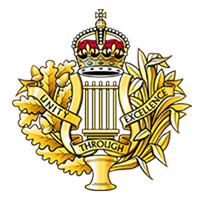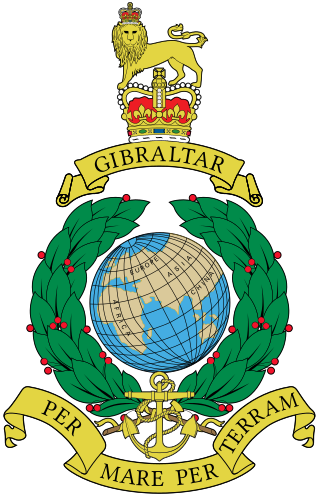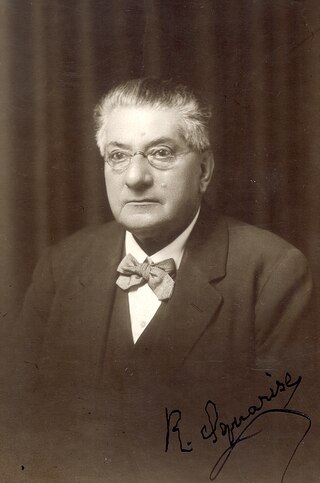Related Research Articles

A military band is a group of personnel that performs musical duties for military functions, usually for the armed forces. A typical military band consists mostly of wind and percussion instruments. The conductor of a band commonly bears the title of Bandmaster or Music director. Ottoman military bands are thought to be the oldest variety of military marching bands in the world, dating from the 13th century.

The Royal Corps of Army Music is a Corps of the British Army dedicated to the provision and promotion of military music.

Frederick Joseph Ricketts was an English composer of marches for band. Under the pen name Kenneth J. Alford, he composed marches which are considered to be great examples of the art. He was a Bandmaster in the British Army, and Royal Marines Director of Music. Conductor Sir Vivian Dunn called Ricketts "The British March King". Ricketts' frequent use of the saxophone contributed to its permanent inclusion in military bands. His best known work is the "Colonel Bogey March".
Sir John Dean Goffin was one of New Zealand's first prolific Salvation Army composers who composed not only music for the Army but for non-Army bands as well.

The Royal Marines Band Service is the musical wing of the Royal Navy and an independent element of the Royal Marines. It currently consists of five bands plus a training wing – the Royal Marines School of Music at HMS Nelson – and its headquarters is at HMS Excellent, Whale Island, Portsmouth.

A brass band is a musical ensemble generally consisting entirely of brass instruments, most often with a percussion section. Ensembles that include brass and woodwind instruments can in certain traditions also be termed brass bands, but may be more correctly termed military bands, concert bands, or "brass and reed" bands.

The 7th Regiment of the New York Militia, aka the "Silk Stocking" regiment, was an infantry regiment in the Union Army during the American Civil War. Also known as the "Blue-Bloods" due to the disproportionate number of its members who were part of New York City's social elite, the 7th Militia was a pre-war New York Militia unit that was mustered into federal service for the Civil War.

A bandmaster is the leader and conductor of a band, usually a concert band, military band, brass band or a marching band.

Raffaello Squarise, also known as Raphael Squarise, was an Italian violinist, teacher, conductor, and composer, who settled in Adelaide, South Australia, and Dunedin, New Zealand. He was a pioneer in the establishment of classical music in New Zealand.
The Invercargill March is a march composed by Alex Lithgow and named after his home town of Invercargill, in the South Island of New Zealand.
Alexander Frame Lithgow was a Scottish-born, New Zealand and Australian based composer and bandleader known as the "Sousa of the Antipodes". His name is pronounced "Alek" by his family.
Henry James Metcalfe was a bandmaster, composer and publisher of music for Brass band. He served in Ireland in a Depot Battalion of the 3rd Regiment of Foot, 'The Buffs', becoming bandmaster of its Bugle, Fife and Drum band. Leaving the army in 1857 due to ill-health, he moved to Walsall, Staffs., founded a brass band and began writing music for it. Shortly after, he relocated permanently to Wolverhampton, Staffs., and continued as a bandmaster, composer and publisher of music for such ensembles.
Eric Walter John Ball OBE was a British composer, arranger and conductor of brass band music, described as "one of the most prolific writers and influential figures in the brass band and choral world".
Charles O'Neill was a Canadian bandmaster, composer, organist, cornetist, and music educator of Scottish birth and Irish parentage. Although he wrote many symphonic and choral works, the majority of his compositional output was devoted to band music.

The Royal Artillery Mounted Band was a British military band consisting of woodwind, brass, and percussion instruments, and military unit, founded in 1886, and in existence until 1984, representing the Royal Artillery, and the Royal Horse Artillery, and augmenting the Royal Artillery Band at royal and state occasions.

Charles Trussell aka Carlile Vernon, was a prominent musician in brass bands both in Australia and New Zealand during the late nineteenth and early twentieth centuries. He served as band master of a number of bands in both countries and was a significant composer and arranger of brass band music. He also was an adjudicator at brass band contests. He is also believed to have written vocal music. He is not to be confused with American banjoist and composer H. C. Trussell who was also active in the late 19th and early 20th centuries.

The New Zealand Army Band is a brass band that primarily provides musical support for the New Zealand Army at all state and ceremonial occasions. It was founded in 1964 by Captain James Donald Carson (1934–2008) of the Royal New Zealand Infantry Regiment.

The Band of the Royal Regiment of New Zealand Artillery is a voluntary military band of the Royal Regiment of New Zealand Artillery. The band is based in the south eastern Auckland suburb of Mount Wellington, and was part of the Army Reserve up until 2012. The Band has an agreement with 16th Field Regiment, Royal New Zealand Artillery, which allows the band to retain its name and uniform.

The Royal New Zealand Navy Band is the musical arm of the Royal New Zealand Navy, serving its musical needs from its headquarters at HMNZS Philomel on Devonport Naval Base, North Shore City, Auckland.

Friedrich Wilhelm Anton Brase, known as Fritz Brase, was a German military bandmaster, conductor, and composer who was mainly active in Dublin, Ireland, as leader of the first Army School of Music in the Irish Free State.
References
- ↑ "Official Record". 1886.
- ↑ Parliament, New Zealand (1911). "Parliamentary Debates".
- ↑ "Follow the Bands - Nelson Photo News - No 88 : March 9, 1968".
- ↑ "History".
- ↑ "Military | NZETC".
- ↑ "Our Grounds".
- ↑ "Papers Past" "Nelson Garrison Band" Colonist, Nelson, 15 December 1899
- ↑ "Papers Past" "Test March for New Plymouth Contest", 22 February 1902
- ↑ "Garrison Band Has New Home - Nelson Photo News - No 18 : April 28, 1962".
- ↑ Cox, Peter (April 2015). Good Luck to All the Lads: The Wartime Story of Brian Cox 1939–43. ISBN 9781775592198.
- ↑ "Military bands, 1900 onwards".
- ↑ "Brass band turns 160".
- ↑ Untitled, Colonist| volume=XLVII| issue=11333, 16 May 1905, Page 2
- ↑ "Maurice Abrahams: Musician, soldier, family man and treasure". 23 November 2018.
- ↑ "Notables O-R". 16 April 2019.